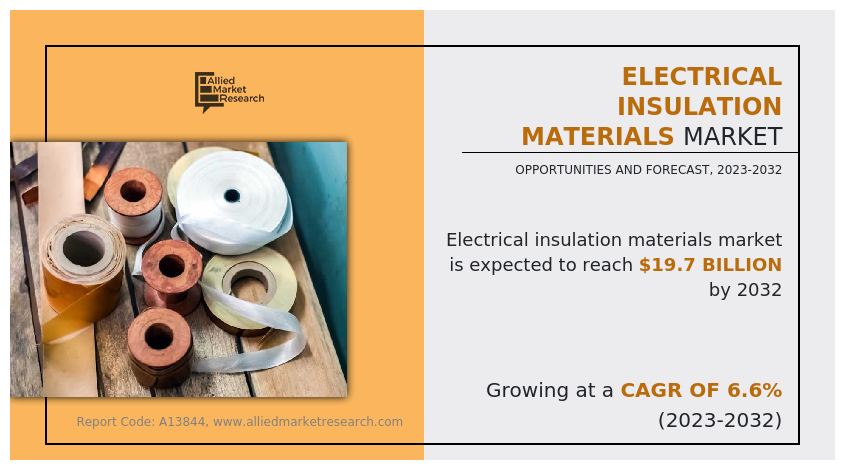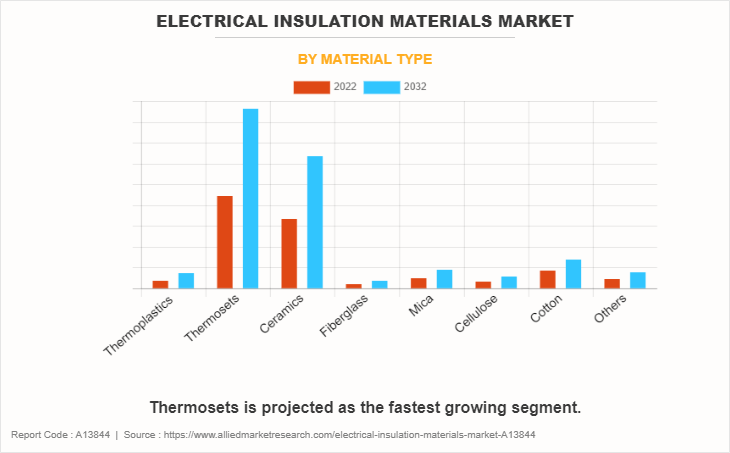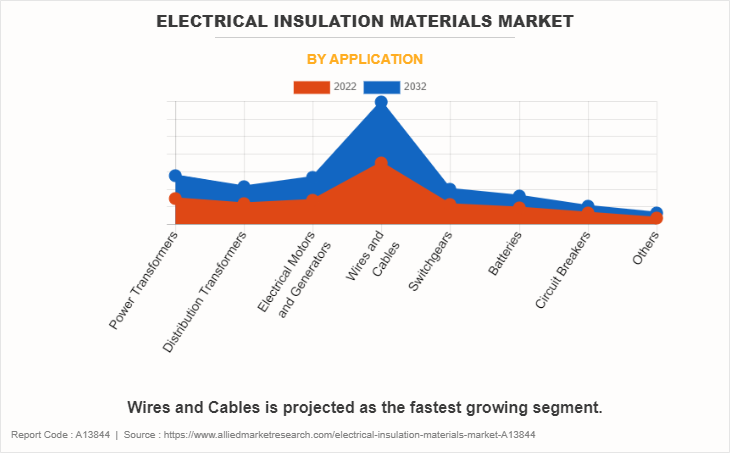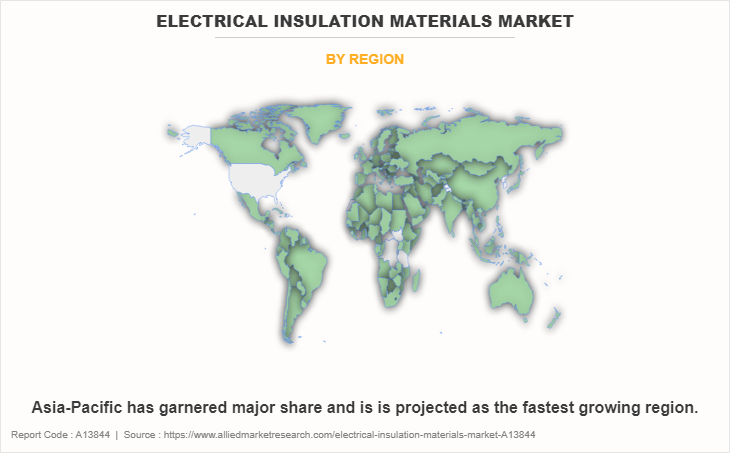Electrical Insulation Materials Market Outlook - 2032
The global electrical insulation materials market size was valued at $10.4 billion in 2022, and is projected to reach $19.7 billion by 2032, growing at a CAGR of 6.6% from 2023 to 2032. The growth of the electrical insulation materials market is fueled by the rising demand for electric vehicles (EVs), which require efficient insulation for enhanced performance and safety. In addition, increasing infrastructure investments in emerging economies, including power grids and renewable energy systems, amplify the need for high-quality insulation materials to support energy efficiency and durability in construction and industrial applications.
Report Key Highlighters:
- The electrical insulation materials market study covers 20 countries. The research includes a segment analysis of each country in terms of value ($Million) and volume (Kilotons) for the projected period 2023-2032.
- The study integrated high-quality data, professional opinions and analysis, and critical independent perspectives. The research approach is intended to provide a balanced view of global markets and to assist stakeholders in making educated decisions in order to achieve their most ambitious growth objectives.
- Over 3,700 product literature, annual reports, industry statements, and other comparable materials from major industry participants were reviewed to gain a better understanding of the market.
- The electrical insulation materials market is highly fragmented, with several players including Nitto Denko Corporation, 3M, Dow Inc., Resonac Holdings Corporation, Elantas GmbH, Krempel GmbH, Owens Corning, Siemens, General Electric, and Bharat Heavy Electricals Limited.

Electrical insulation materials are substances that impede the flow of electrical current, preventing unwanted conductive pathways and ensuring the safe and efficient operation of electrical systems. These materials possess properties such as high dielectric strength, low electrical conductivity, and thermal stability. They effectively isolate conductors and components, preventing short circuits, electrical leakage, and hazards.
In addition, insulation materials exhibit resistance to temperature fluctuations, chemicals, moisture, and mechanical stress. They are vital components in various applications, from power transmission and electronics to automotive and aerospace, ensuring reliable and secure electrical performance while safeguarding personnel and equipment from potential electrical risks.
Increasing demand for EVs is expected to drive the growth of the electrical insulation materials market during the forecast period.
In EVs, electrical insulation materials are utilized to protect electronic components and reduce conductivity. The sales of electric vehicles (EVs) have increased due to the increase in emphasis on fuel economy, emission targets, and changes in consumer attitudes toward their adaptability. EV sales were increased from 6.6 million in 2021 to 11.2 million in 2025 and 31.1 million by 2030. By 2030, this segment accounted for approximately 32% of new vehicle sales. In 2020, EV sales accounted for 2% of total car sales in the U.S.
According to Climatewire, sales of light-duty vehicles increased to 5% in 2021, while sales of all passenger vehicles increased to 20%. Ford Motor Company and SK Innovation have announced investments totaling USD 11.4 billion in new EV and battery production facilities in Tennessee and Kentucky. Reservations for 130,000 Ford F-150s with a launch date of May 2021 have been made. By the end of 2022, 40 new EV models were available on the US market. The US government passed a USD 3.5 trillion reconciliation package that includes a USD 7,500 EV tax credit and an additional USD 4,500 incentive if EVs manufactured in the union are assembled in the country. This has increased the EV market in the U.S.
Increase in infrastructure investments in emerging economies
Electrical insulation materials such as thermoplastics, thermosets, ceramics, and porcelain are utilized extensively in the production of various electrical components. These components include power transformers, distribution transformers, electrical motors and generators, wires and cables, switches, batteries, circuit breakers, shackles, and pin insulators. These components are widely employed in infrastructure activities, including residential construction, commercial construction, and industrial construction. The market for electrical insulation materials is expected to be driven by a rise in safety measures and an increase in the installation of safety components in the construction industry during the forecast period.
The Asian Development Bank (ADB) has approved a $250 million loan to support the National Industrial Corridor Development Programme (NICDP) in November 2021. This is a portion of the 500-million-dollar credit to construct eleven industrial corridors in seventeen Indian states. According to information published by the U.S. Council on Foreign Relations, in November 2021, Congress approved a historic investment in the U.S. infrastructure consisting of hundreds of billions of dollars in additional expenditure. These are some of the most important market drivers for electrical insulation materials during the forecast period.
The growth of the electrical insulation materials market is constrained due to stringent environmental regulations and sustainability concerns. Industries are compelled to adopt more eco-friendly practices and materials as global awareness of environmental impact intensifies. This shift limits the use of insulation materials that contain hazardous substances or have negative ecological consequences during production, use, or disposal.
Renewable energy sources are located at great distances from populated areas. In such situations, high-voltage direct current (HVDC) cables are utilized. These transmission lines require continuous and consistent monitoring of the entire system to ensure minimal losses and fault protection. They are the most efficient method of long-distance electricity transmission. Moreover, the use of insulation materials for HVDC cables can take place underground or beneath the seafloor. In Europe, it is anticipated that projects such as NordLink are projected to connect southern Norway and Germany. The HVDC cable initiatives are an integral component of Energiewende (plan for environmentally sustainable energy supply) of Germany. Consequently, HVDC transmission for long-distance transmission lines provides lucrative market opportunities.
The electrical insulation materials market is segmented into material type, application, and region. On the basis of material type, the market is divided into thermoplastics, thermosets, ceramics, fiberglass, mica, cellulose, cotton, and others. On the basis of application, it is categorized as power transformers, distribution transformers, electrical motors and generators, wires and cables, switchgears, batteries, circuit breakers, and others. On the basis of region, the market is studied across North America, Europe, Asia-Pacific, and LAMEA.

Electrical Insulation Materials Market By Material Type
The thermosets segment accounted for more than two-fifths of the global electrical insulation materials market revenue in 2022 and is expected to register the highest CAGR of 6.9% during the forecast period. Thermosets are polymer materials that exhibit high stability and strength due to their crosslinked molecular structure, making them suitable for applications demanding durability and heat resistance. They find extensive use in industries like automotive, aerospace, and electronics, driven by their ability to withstand elevated temperatures, chemicals, and mechanical stress. This property combination positions thermosets as crucial materials for creating long-lasting and resilient products in various demanding environments.

Electrical Insulation Materials Market By Application
The wires and cables segment accounted for more than one-third of the global electrical insulation materials market revenue in 2022 and is expected to register the highest CAGR of 7.1% during the forecast period. Wires and cables serve as vital conduits for electrical transmission. Insulation materials enveloping these conductors prevent energy leakage, ensuring safe and efficient power transfer. Dielectrics like rubber, PVC, and polyethylene shield against current leakage and maintain signal integrity. This electrical insulation safeguards both people and equipment, enabling the reliable functioning of various electrical systems and devices.

Electrical Insulation Materials Market By Region
Asia-Pacific garnered the largest share for nearly half of the global Electrical insulation materials market revenue. The Asia-Pacific electrical insulation materials market is driven by rapid urbanization, increasing energy consumption, and expanding electrical infrastructure. The growing demand for high-voltage equipment, renewable energy projects, and technological advancements are propelling the market. In addition, stringent safety regulations and the need for reliable power distribution systems are further boosting the demand for efficient electrical insulation materials in the region.
Competitive Landscape:
The players operating in the global electrical insulation materials market are Nitto Denko Corporation, 3M, Dow Inc., Resonac Holdings Corporation, Elantas GmbH, Krempel GmbH, Owens Corning, Siemens, General Electric, and Bharat Heavy Electricals Limited. The unique technologies and innovative approaches of the abovementioned companies contribute to the advancement of the electrical insulation materials market.
Nitto Denko Corporation: Nitto Denko is a Japanese company that produces a wide range of materials, including electrical insulation tapes, films, and sheets. They offer products for various applications, such as electrical insulation, bonding, and protection, catering to industries like electronics, automotive, and energy.
3M Company: 3M is a multinational conglomerate known for its diverse range of products. In the context of electrical insulation materials, 3M produces tapes, films, and coatings that provide electrical insulation, heat resistance, and mechanical protection. Their products are widely used in electronics, automotive, and energy sectors.
Dow Inc.: Dow produces a variety of materials, including electrical insulation materials such as coatings, resins, and adhesives. These materials find applications in the construction, electronics, and industrial sectors for insulating and protecting electrical components.
Resonac Holdings Corporation: Resonac is a Japanese company specializing in electrical insulation materials, particularly in the field of transformers and power equipment. They manufacture insulating papers, films, and other materials crucial for the reliable operation of electrical systems.
Elantas GmbH: Elantas, a division of the ALTANA Group, is a leading manufacturer of insulation materials. They offer a wide range of products, including wire enamel, impregnating resins, and casting compounds used in electrical equipment and systems.
Krempel GmbH: Krempel is a German company that produces electrical insulating materials such as laminates, composites, and insulation papers. Their products are used in electrical machinery, power generation, and other industrial applications.
Owens Corning: While primarily known for insulation products in the construction industry, Owens Corning also produces insulation solutions for electrical applications. They offer glass-fiber reinforced products used in electrical equipment and systems.
Siemens: Siemens is a global conglomerate with a wide range of products, including electrical insulation materials. They provide solutions for electrical engineering and automation systems, offering insulating materials for electrical components and systems.
General Electric (GE): GE produces a diverse array of products, including electrical insulation materials for power generation, transmission, and distribution. They offer solutions for transformers, motors, and other electrical equipment.
Bharat Heavy Electricals Limited (BHEL): BHEL is an Indian company that manufactures electrical equipment, including transformers, generators, and insulation materials. They produce insulating materials required for the efficient functioning of electrical systems.
Each of these companies plays a significant role in the manufacturing of electrical insulation materials, offering a wide range of products that contribute to the reliability and safety of electrical systems in various industries.
Other players include ABB, Rogers Corporation, ITW Formex, Polycraft Composites, Toray Industries, Sumitomo Bakelite Co., Ltd., Changzhou Suli Insulating Products Co., Ltd., Suzhou Jufeng Insulating Material Co., Ltd., Zhejiang Yage Electronic Technology Co., Ltd., Haysite Reinforced Plastics, Lamart Corporation, and Electrolock, Inc.
Historical Trends in Electrical Insulation Materials
Discovery and Initial Uses (Early 1900s):
The use of electrical insulation materials began with natural substances like rubber, paper, mica, and cotton, which provided basic insulating properties for early electrical systems. These materials were readily available and helped establish the foundational understanding of insulation's role in electrical safety and performance.
Industrial Advancements and New Materials (1920s-1940s):
The advent of synthetic materials revolutionized insulation, with the introduction of Bakelite, the first synthetic thermosetting plastic. This period also saw the development of fiberglass and other heat-resistant materials, which significantly improved the reliability and efficiency of electrical systems.
Expansion with Electrification and WWII (1940s-1950s):
The post-war period's rapid electrification and industrial growth demanded advanced insulating materials. Polyurethane and other polymers were developed for enhanced durability, flexibility, and thermal resistance. These materials were widely adopted in power distribution and electrical machinery.
Emergence of High-Voltage Applications (1960s-1980s):
The rise of high-voltage transmission systems and industrial automation increased the demand for materials like cross-linked polyethylene (XLPE) and ethylene propylene rubber (EPR). These innovations offered superior thermal and dielectric properties, making them ideal for power cables and transformers.
Environmental Awareness and Advanced Composites (1990s-2000s):
Growing environmental regulations led to the development of eco-friendly insulating materials with reduced hazardous content. The market also witnessed the adoption of advanced composites and silicone-based materials, enhancing insulation in extreme environments, such as aerospace and underwater applications.
Sustainability and Smart Technologies (2010s):
Insulation materials started to integrate with smart technologies, such as sensors and monitoring systems, for predictive maintenance. The focus on sustainability grew, with research into recyclable and bio-based materials to minimize the environmental impact of electrical systems.
Market Growth and Diversification (2020s-2024):
The demand for electrical insulation materials has surged due to the rise of electric vehicles, renewable energy, and modern infrastructure projects. Nanotechnology and advanced manufacturing techniques have enabled the production of materials with superior thermal, mechanical, and electrical properties, driving diversification across industries such as automotive, electronics, and construction.
Impact Of Russia Ukraine War On the Electrical Insulation Materials Market:
- Key suppliers of raw materials, components, or finished products in the electrical insulation materials market are located in the conflict-affected region, there could be disruptions in the supply chain. This might lead to shortages, delayed deliveries, and increased costs due to transportation challenges.
- Supply chain disruptions can lead to price volatility as demand for electrical insulation materials remains steady or increases. Shortages could drive prices up, affecting manufacturing costs and potentially impacting end-users.
- Geopolitical conflicts can create uncertainty in global markets. Businesses might delay investment decisions or alter their procurement strategies until the situation stabilizes. This uncertainty could impact overall electrical insulation materials market growth.
- Companies in industries reliant on electrical insulation materials might consider diversifying their supply sources to mitigate geopolitical risks. This could lead to changes in supplier relationships and geographical sourcing patterns.
- Depending on the industries affected by the conflict and their reliance on electrical insulation materials, there might be variations in regional demand. Industries heavily tied to the conflict-affected regions might experience disruptions or shifts in their operations, impacting their demand for these materials.
- Geopolitical tensions could lead to trade restrictions, tariffs, or export-import challenges. This could hinder the smooth flow of materials and products across borders, affecting the electrical insulation materials market's global dynamics.
- Geopolitical uncertainties might lead to a slowdown in investment and innovation in sectors like renewable energy and electronics, which are significant consumers of electrical insulation materials. Businesses might delay projects or seek alternatives.
- Industries could reevaluate their long-term supply chain strategies to minimize exposure to geopolitical risks. This might involve reshoring or relocating certain manufacturing operations to regions considered more stable.
- Geopolitical conflicts can lead to changes in trade agreements and regulations. This could impact compliance requirements, logistics, and cost structures for businesses operating in the electrical insulation materials market.
Key Benefits For Stakeholders
- This report provides a quantitative analysis of the market segments, current trends, estimations, and dynamics of the electrical insulation materials market analysis from 2022 to 2032 to identify the prevailing electrical insulation materials market opportunities.
- The market research is offered along with information related to key drivers, restraints, and opportunities.
- Porter's five forces analysis highlights the potency of buyers and suppliers to enable stakeholders make profit-oriented business decisions and strengthen their supplier-buyer network.
- In-depth analysis of the electrical insulation materials market segmentation assists to determine the prevailing market opportunities.
- Major countries in each region are mapped according to their revenue contribution to the global market.
- Market player positioning facilitates benchmarking and provides a clear understanding of the present position of the market players.
- The report includes the analysis of the regional as well as global electrical insulation materials market trends, key players, market segments, application areas, and market growth strategies.
Electrical Insulation Materials Market Report Highlights
| Aspects | Details |
| Market Size By 2032 | USD 19.7 billion |
| Growth Rate | CAGR of 6.6% |
| Forecast period | 2022 - 2032 |
| Report Pages | 506 |
| By Material Type |
|
| By Application |
|
| By Region |
|
| Key Market Players | Siemens, Dow Inc., Elantas GmbH, Owens Corning, General Electric, Resonac Holdings Corporation, 3M Company, Bharat Heavy Electricals Limited, Nitto Denko Corporation, Krempel GmbH |
Analyst Review
According to the insights of the CXOs of leading companies, the increase in demand for energy-efficient solutions in power generation, transmission, and distribution spurs the need for advanced insulation materials to reduce energy losses and drives the market growth of electrical insulation materials. Rapid urbanization and industrialization further drive the market, as expanding infrastructure requires reliable electrical systems. However, the high prices of volatile raw materials and environmental concerns associated with certain insulation materials are expected to hinder market growth.
The CXOs further added that the rise in adoption of renewable energy sources such as solar and wind power and the growth of electric vehicles and smart grid technologies offers lucrative opportunities for the growth of the electrical insulation materials market.
The electrical insulation materials market attained $10.4 billion in 2022 and is projected to reach $19.7 billion by 2032, growing at a CAGR of 6.6% from 2023 to 2032.
The Electrical Insulation Materials Market is studied across North America, Europe, Asia-Pacific, and LAMEA.
Wires and Cables is the leading application of Electrical Insulation Materials Market.
Increase in demand for transmission and cable lines and increase in infrastructure investments in emerging economies are the driving factor of Electrical Insulation Materials Market.
Nitto Denko Corporation, 3M, Dow Inc., Resonac Holdings Corporation, Elantas GmbH, Krempel GmbH are the top companies to hold the market share in Electrical Insulation Materials.
Asia-Pacific is the largest regional market for Electrical Insulation Materials.
Growth in demand for renewable energy is the upcoming trend of Electrical Insulation Materials Market in the world.
Loading Table Of Content...
Loading Research Methodology...



